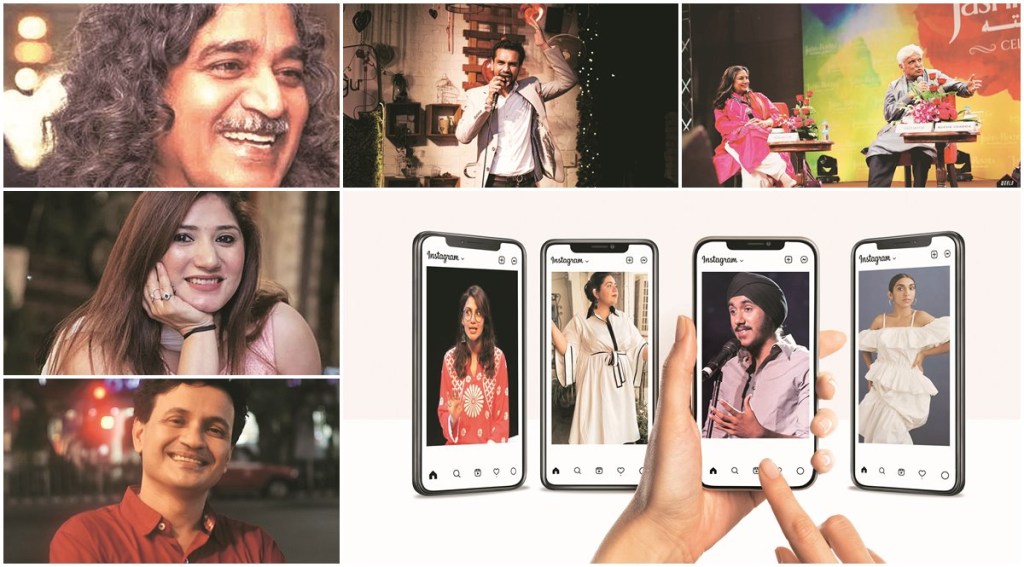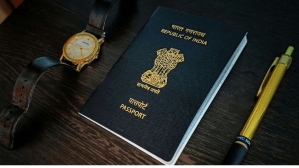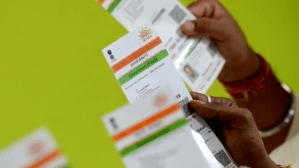Rupi Kaur, an India-born Canadian national, has been performing poetry since 2009 but she rose to prominence only in 2015 through Instagram. With 4.4 million followers now and a world tour lined up later this year, Kaur, 29, has published three collections of poetry, two of which have been New York Times bestsellers.
Her writing style is simple, and grammar is not a roadblock – the same reasons for which she is often criticised. Yet that has not held her back from hosting the Giller Prize, a literary award given to a Canadian author, and even appearing on The Tonight Show Starring Jimmy Fallon. She has found a large fan base among youngsters who want to read poetry but as fast as they can scroll the screens of their smartphones.
“we’ve worked so hard to be here we can afford to slow down and enjoy the view,” writes Kaur in a conversational, colloquial tone in her collection of poetry, home body, in 2020.
Kaur is one of the several Instagram poets or ‘Instapoets’ who emerged after the advent of social media. Instapoetry is a term that can be used to describe poems written specifically for being shared online, most commonly on Instagram, but also other platforms including Twitter, Tumblr and TikTok.
Such a form usually consists of short, direct lines in aesthetically pleasing fonts that are sometimes accompanied by an image or drawing, with or without a rhyme scheme. Brevity is their mantra and informality their mood, social issues are their themes and social media their publisher.
To define it in a sentence, Instagram poetry is no different than an Instagram picture caption – short but deep yet dramatic and intense. Thanks to millions of users of Instagram, largely young, the connectivity with Instagram poetry is instant and deep – here anyone can be a (Instagram) published writer, go viral quickly and write without the worry of finding acceptance or censorship.
Another Indian Instagram poet who seems to have struck a chord with the Indian millennial and Gen-Z population is Nikita Gill. In her poem titled Gentle Reminder, she writes: “The rose is not everyone’s favourite flower, but that does not make it any less beautiful. There is a lesson for all of us in that.” Gill, with over 6,35,000 Instagram followers, has also published several books and volumes of poetry.
If comfort poetry is one’s cup of tea, writer Harnidh Kaur’s Instagram page never fails to impress. With more than 37,000 followers on the social media platform, she posts poetry that appeals to the soul. Actor-turned-poet Arunoday Singh, with 1,26,000 followers on Instagram, too, has his share of poetry inked dramatically in Sufi style on paper. Rightly, he goes by the name ‘sufisoul’ on Instagram.
Then there are many accounts that share poems of new and known names in the world of modern poetry and make them accessible to a larger audience. ‘Poets of Instagram,’ one of the most popular poetry pages on Instagram, shares Instapoetry from several poets and is a one-stop platform for scroll-through poetry. Since social media comes with a promise of visibility, spoken word poetry has its own fanbase and Instagram pages like UnErase Poetry with 8,48,000 followers offer performance poetry videos of artists to a large audience.
Another Instagram poet making huge waves is Yung Pueblo (which means ‘young people’), the pen name of writer Diego Perez. With 2.1 million followers on Instagram, Perez calls himself ‘meditator, writer and speaker’. He writes deep thoughts and quotes on life, but in the window of an Instagram post. “make deep connections, not deep attachments”, “if the pain was deep you will have to let it go many times,” are his words signed under his pen name.
However, not everyone goes by the idea of such poetry. Sahitya Akademi winner and poet Ranjit Hoskote does not believe that Instagram poetry is a genre. Hoskote, whose poems have received global recognition and appreciation, says poetry is not defined so much by the platform. “To some extent, yes, depending on what technology it is. I am just interested in good poetry, no matter what platform. I am not interested in segregating by platforms, I am interested in doing the opposite — I would embrace the diversity of platforms. Haiku, for instance, was written in the 12th century. So, I don’t think readers are confining themselves to a format either,” he states, pressing on the need to accept poetry regardless of genres and platforms.
Hoskote is currently working on the translations of the works of Mir Taqi Mir, a great poet at the turn of the 18th-19th century. He defines the major shifts that online platforms have brought in as focal points for new communities encouraging other forms of writing poetry. “It is now available in multiple avatars – stage poetry, hybrid, podcasts, there are different ways in which poets and audience are connected,” he adds.
Emotions & revelations
While yesteryear’s generation connected with Sahir Ludhianvi, today’s generation finds comfort in spoken word poetry and emotions written on Instagram.
In 2021, television actor Sriti Jha went viral for a unique reason. In a video that was widely circulated on social media, the actor was seen performing Confessions of a Romantic Asexual, as she revealed being asexual through her poem. The poetry was performed during Spoken Fest in Mumbai in 2020. “I learned to lie in words and in moans,” said the actor while performing her poetry, talking about her struggles as an asexual person.
Back in 2017, poet Simar Singh strongly spoke on marital rape through his poem The Legal Rapist in his viral video. “So many young boys have been taught this crime as a ritual,” he said in his poetry as he shocked the audience with his words at only 16 years of age back then.
The following year, Akanksha Sinha and Poorvika Mehra gave goosebumps to the audience as they performed their poetry When We Talk About Rape in which they explained the physical and mental trauma of a rape survivor.
When we talk about performance poetry, we talk about strong emotions, revelations, angst built up against society and challenging stereotypes. Perhaps this is the reason why the young are resonating with performance poetry – the latest offering in poetry. This has also given space to resistance poetry that has become the norm during historic events such as the Russia-Ukraine war, the farmer protests and so on.
The upside of writing resistance poetry on social media remains that the poet does not have to get into the politics of getting an opinionated piece published and can instead choose a more democratic way to voice his/her opinion on his/her own terms on social media.
Performance or spoken word poetry has found many takers — social media, physical spaces or gatherings, local fests, online platforms or cafes and clubs. An online portal Delhi Poetry Slam, also called DelSlam, is a leading literary platform to promote such a new generation of poets while poet & researcher Madhu Raghavendra runs a community Poetry Couture to promote the culture of poetry and performance arts.
It is the love for poetry and the power it gives to voice out emotions among the young generation that led to the creation of Gurugram’s Guftagu Café, which proudly calls itself India’s first poetry café, established in 2018. The co-working café offers weekly poetry sessions and stand-up comedies for both new and renowned artists.
Kritika Wasson, founder of Guftagu, shares that the café hosts open mic every week and has collaborations with short video apps like Moj and Josh. With over 200 artistes associated with the café, the content created during closed sessions are uploaded on the apps and Guftagu’s social media pages as well as the social media pages of the artistes to reach out to a larger audience. Wasson shares, “A number of new and known names in the poetry circuit send us content. Our team reviews them, and we invite five new and five experienced artistes to our stage every Sunday. Although we have old-style shayari, our main objective is to promote the new style of poetry, that is, slam, free style, spoken word, as that resonates with the younger generation. The audience has to buy tickets to these closed sessions that cost around Rs 200-800.”
Wasson says that post the pandemic, the consumption of content — both stand-up and poetry — has gone up several notches as people had the time to watch new content on social media during the lockdown. Videos went viral and Reels were trending. The content industry boomed like never before as artistes created content online and the audience consumed it. Naturally, when public places started opening up, there was a newfound love and awareness for stand-up and new-style poetry. “We have reputed platforms like Rekhta that promote poetry as well but that caters to a mature audience that understands literature. The benefit of having poetry cafés is that you don’t need to know literature to enjoy it. Anyone can be a part of our poetry and stand-up session. It is more of entertainment and less of literature.”
Wasson believes that with this, north India is learning to appreciate and accept new-style poetry and stand-ups and the consumption and creation patterns are moving away from Mumbai. “There was nothing of this sort happening in north India though Mumbai is a hub of new-style poetry and stand-ups,” she says, adding that with the success of Gurugram’s Guftagu Café, they are now planning to launch in Delhi and Chandigarh by March 2023.
Though cafés like Guftagu are becoming spaces for the young to engage in conversations and share their creations, the fact that literary and cultural festivals like Jaipur Literature Festival and Jashn-e-Rekhta have inspired smaller and more intimate gatherings that promote poetry cannot be denied.
Sanjiv Saraf, founder of Rekhta that organises the world’s largest Urdu literary festival, agrees that the success of festivals like Jashn-e-Rekhta and Jaipur Literature Festival have led to smaller poetry gatherings happening locally and have helped promote the culture of poetry in general. Saraf has recently penned down Love Longing Loss in Urdu Poetry in which he has translated several popular Urdu couplets and poems.
India’s Silicon Valley, Bengaluru, too is not untouched by the charms of poetry. Bengaluru Poetry Festival, the city’s only literary festival dedicated to poetry, started in 2016 and has attracted a number of fans every year. The festival gives a platform to artistes and poets to showcase hymns and haikus, modern and traditional poetry, ballads and odes.
Modern avatar
From legendary Indian poets like Amrita Pritam, Rabindranath Tagore, Mahadevi Verma and Sahir Ludhianvi to the greatest voices in contemporary literature like Meena Kandasamy and the most prominent Instagram poets like Rupi Kaur, the Indian poetry scene has been through a sea change. Yet, the modern bard continues to appeal to the contemporary reader’s soul.
Poet, author and academician Ashwani Kumar says that the conventional mushairas have faded, but performance poets like Kumar Vishwas, Hussain Haidry and Aryana Johar have made poetry so popular with the masses. “Further, poetry is now a new address of feminist, Dalit and protest movements in general. How can we forget that Faiz Ahmad Faiz’s Hum dekhenge became the rallying ground of protests against CAA and NRC in the recent past? During the coronavirus pandemic, poetry got a new lease of life. It also led to conversations with the poets on ideas of solitude and isolation,” he says.
Kumar explains that proliferation of poetry into small towns has reflected in the establishments of boutique and independent publishing houses in regional languages and English as well. He says, “Predictably, mainstream publishers are competing with boutique and independent poetry publication houses. In fact, there is an excess of poetry publishing — a new form of renewal and fecundity of poetic life in our troubled times.”
In February this year, Dublin-based Indian poet Nidhi Zak/Aria Eipe’s debut poetry collection Auguries of a Minor God was longlisted for this year’s Dylan Thomas Prize that is worth 20,000 pounds. The prize, in partnership with Swansea University, celebrates all forms of fiction, including drama, short stories, poetry and fiction.
Avinab Datta-Areng, who has recently written his first collection of poems Annus Horribilis, an ensemble of impressionistic poems, published by Penguin Random House India and who has been a recipient of the Charles Pick fellowship and the Vijay Nambisan fellowship. believes that poetry is going to be relevant as long as human existence is relevant. “I think people invested in poetry, as ever, are putting up a brave front, despite the odds. It’s definitely better than it was before, but the dearth is such that it can always get even better.” Datta-Areng, has been co-editing nether, an independent literary journal, which heavily leans towards poetry, for the past decade.
Ashwani Kumar, who is the co-curator of Chandrabhaga Poetry Festival and co-founder of Indian Novels Collective, labels a literary publishing house as a strange beast and calls poetry a distant cousin. He says that during the pandemic, poetry has acquired a cult status and emergence of a distinctive ‘poetry economy’ in the publishing world is one of the most surprising developments of print capitalism. Translation of regional language poets has also led to the popularity of regional works among publishing houses, he says.
Saikat Majumdar, professor of English and creative writing in Ashoka University who has recently penned down The Middle Finger published by Simon & Schuster India, is clear that the mainstream publishers are hesitant about poetry. According to him, they seem to be publishing two kinds of poets – established poets with wide and secure reputations, and figures with wide social media following, primarily on Instagram. “Of course, there are some really striking collections that they put out. But some of the most exciting and daring poetry in India is coming out from smaller publishers with special poetry lists,” he adds, saying that over the years, some of the most remarkable books he has read have come from Poetrywala, Red River, Copper Coin – The House of Sublime Poetry, Hawakal, Dhauli Books and other publishing houses.
Majumdar’s latest book, The Middle Finger, in which the protagonist is a poet, is written in lyrical prose style. On being asked why he chose the style, he says that it has to do with the innate stylistic identity of a writer. “Though I don’t write poetry myself, I’m very drawn to the immediate, sensory, and atmospheric, and this shapes my relationship with language and narrative. That is possibly why my writing is sometimes described as ‘lyrical’ or ‘poetic’,” he says. The protagonist in the book is preoccupied with the difference between poetry in print, and poetry performed, both in real life and on social media, particularly with the way the latter heightens the physical and sensory features of poetry that gets lost or transformed in the printed word, he says.
As for the readership of poetry, Majumdar says that poetry might be making small comebacks in performative forms and social media but adds that books by new and contemporary poets find less takers in readers, who are often interested in books that are newsy, that talks about contemporary topical issues, mostly political.
Rashmi Parekh, debutante poetess and author of 2021 poetry book Inscape – Lost Words Found says, “The most beautifully written poems are ones that connect with their audience using minimal but impactful words. Whether one chooses to write a poem to express mental and emotional turmoil with all that is happening in the world or whether you write to express a fantastical journey in an imaginary universe, a poem is a comparatively short but impactful canvas.” Her collection of poems represents her journey through the years and her milestones. Parekh is confident as a writer that poetry has the universal power to overcome barriers of age and genders, geographies and languages and will continue to stay relevant for generations to come.
Publishers’ perspective
Publishing houses in India and worldwide have conveniently stepped into a new era of publishing that encompasses the audio segment. The poetry genre too has found new takers in the last decade with the emergence of literary festivals. And with the onset of modern poetry and the emergence of new poets – Instagram poets included, publishing houses are finding a golden opportunity to rope in known and new names in poetry.
Penguin Random House India will soon be publishing Unsung, a collection by Arunoday Singh whose poems have found a dedicated following on Instagram.
Sohini Basak, commissioning editor and foreign rights, HarperCollins India, believes that English-language poetry publishing has always been a niche area in India. “During the first lockdown, many of our writers came forward to send in videos of themselves reading out their favourite comfort poems. Poetry promotion has to be about opening up conversations in various ways between readers, writers and the possible reader because poetry occupies a very personal and emotional space in many of our everyday lives,” she says.
Not just classic and established publishing houses but self-publishing in poetry has become a big deal. The autonomy of owning a book and a readymade social media audience has given the new poets a confidence to venture into publishing. Platforms like Poetrywala too have been pushing the poetry publishing scene in India towards the shore of success. Founded by Hemant and Smruti Divate in 2003, the publishing imprint has published over 130 poetry collections and the founders, along with writers have recently established the Poetrywala Foundation to facilitate research, archiving, translation and poetry in general in the country.
HarperCollins’ Sohini Basak too talks about how over the past five years, small presses like Red River Press have brought out books and new literary journals have flourished, as well as poetry festivals such as the one in Bengaluru have taken off very successfully.
However, Basak feels that ample publishing options for new poetry writers like social media, sharing on stage through performances and self-publishing options means that the readership of traditionally published poetry books is on the decline. “At Harper India, our poetry list has developed into a stellar one over the past five years. What’s interesting to observe is that although there is definitely a proliferation of poetry writers (I receive at least two to three manuscripts every month) in the country, there hasn’t been a corresponding increase in buyers of Indian poetry books, sadly. We desperately want to change that because although individual poems can be read online or in journals, to read a complete book of poetry is to pay attention to the poet’s vision (which usually takes years to develop). I wish more readers experience or would want to experience the richness and satisfaction that comes with reading full-length books,” she adds.
Elizabeth Kuruvilla, executive editor, Penguin Random House India, calls poetry “the most powerful form of literature that captures life and its experiences most intimately,” but agrees that the readership remains small in comparison to fiction and non-fiction books, and that in turn affects the number of poetry titles in a publisher’s list. She shares how “social media spaces have become a potent vehicle for poetry, which has allowed readers to directly and immediately interact with the poets and respond to the poems.”
However, Aparna Kumar, editor, Penguin Random House India, says that comparing the markets of fiction/non-fiction titles and poetry is not fair. “While the readership for these two genres have increased manifold, the devoted readership for poetry has remained the same. This may be one reason why publishing houses today are economical with poetry acquisitions. However, despite the limited representation, people are writing poetry of all kinds across the country,” she explains.
There is no doubt that the shift away from big names in the publishing industry is becoming evident. Kuruvilla of Penguin Random House India says that the younger poets in particular have chosen different avenues to speak their poetry: whether it is through social media pages, or on stage with performance poetry. “Their wide popularity should be an indication, if any were needed, of the fact that poetry is alive, thriving and continuing to probe and give perspective, and those listening or reading to it are being moved and changed by the experience,” she says. Poetry, according to her, demands a deeper, more personal involvement from the reader, and sometimes even reading one poem can have a lasting impact on you.
“Our main objective is to promote the new style of poetry, that is, slam, free style, spoken word, as that resonates with the younger generation”
— KRITIKA WASSON,FOUNDER, GUFTAGU
“During the coronavirus pandemic, poetry got a new lease of life. It also led to conversations with the poets on ideas of solitude and isolation” — ASHWANI KUMAR, CO-FOUNDER, INDIAN NOVELS COLLECTIVE
“Poetry might be making small comebacks in performative forms and social media but books by new and contemporary poets find less takers”
— SAIKAT MAJUMDAR, PROFESSOR, ASHOKA UNIVERSITY








